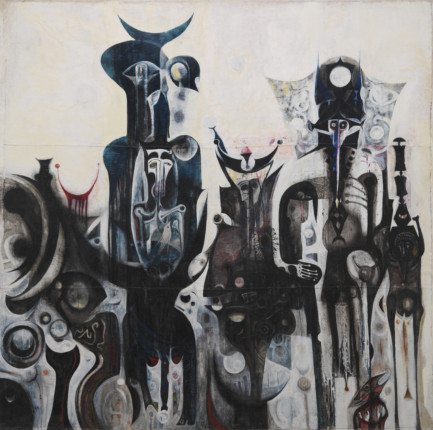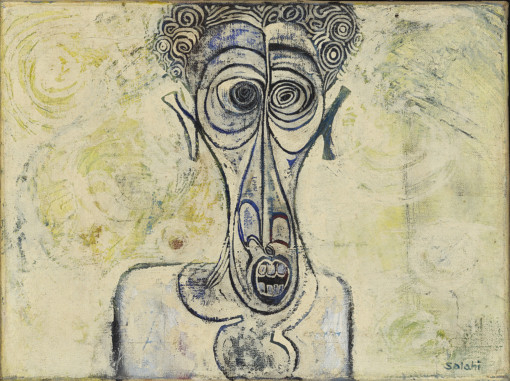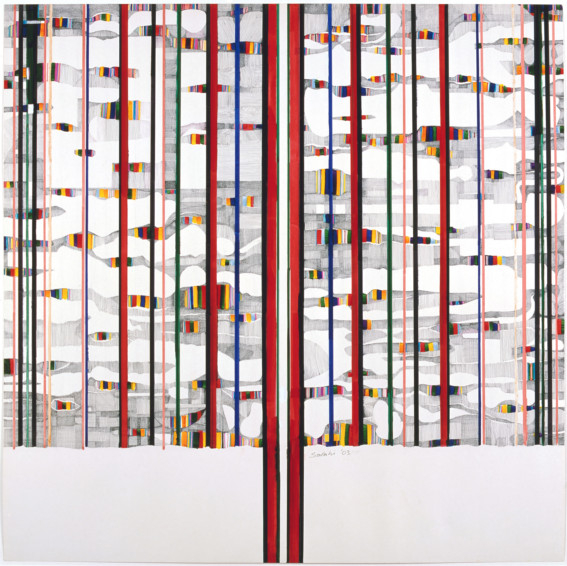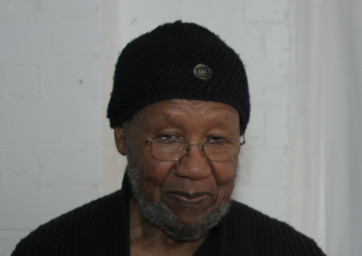
On the banks of the Nile grows what the artist Ibrahim El Salahi calls ‘a very strange tree’, the haraz. In the drought season it flourishes, green and verdant, while the other trees are bare. In the rainy season when the river floods it sheds its leaves and stands stark against the sky line.
“It is very near the Sudanese character,” El Salahi says. “It is a troubled country. It’s like a passage that people are always coming through, from the north, the south, east and west. Some stay, some move out. It is the kind of place which has many movements, many contradictions.
“When I was trying to understand the identity of the country, why it is so different from the others with its own way of thinking, I found its nature in the haraz tree.”
The tree is a symbol — and a subject he returns to again and again in contrasting styles — of the artist’s work which has been evolving and changing and seeking an identity since his boyhood days when he would scrape patterns in the dust outside his house in Omdurman, northern Sudan.
El Salahi is probably the oldest at 83, certainly the most esteemed, of the performers, artists, writers and thinkers who are taking part in the second London festival, Shubbak, A Window on Contemporary Arab Culture. One hundred of his works will be on display at London’s Tate Modern gallery next week (July 3), tracing his work — as a trailblazing modernist using simple black and pen and ink lines — to works inspired by Islamic calligraphy and the decorative works of his homeland and on to challenging works, often politically charged, in black and white.
If his Sudan has “many movements” the Arab world has always been an extraordinary whirl of nationalities, conflicting interests, political opposites, and even more so today since the optimism of the Arab Spring slipped into disappointment and anger.
Shubbak is hosting 16 countries as diverse as Yemen, the UAE, Morocco and Sudan itself, which are unified by a common language and a shared religion, but which, sponsor and organiser Palestinian filmmaker (and British resident) Omar Al Qattan, admits are heterogeneous, each with a political and cultural agenda of its own.
And as El Salahi says of his native Sudan: “It’s many countries, not just one. There are something like 200 languages but it is part of that same mixture of people from North Africa — Egyptians, Moroccans, Algerians and Libyans. There are so many influences, but what you see and what you know and how you mature with age affects a number of attitudes and methods in your own work. My work is that of an individual. That’s the most important thing.”
In the front room of his Oxford home, he talks softly, reflectively, perched on an orthopaedic contraption, which keeps him upright and eases the worst of a bad back and sciatica. It is as if he is seeing the young Ibrahim, the boy drawing in the dust outside his house in the 1930s.
“We didn’t have pencils and paper or crayons, so we used to amuse ourselves when our parents were having a snooze in the midday by sitting and drawing maps of houses in the sand with our fingers. It was a puzzle to see if we could make out which house was lived in by which boy.”
This early instinct for drawing was nurtured by an Anglo-French teacher who helped him win a scholarship to the Slade School of Art in London, where he studied for three years from 1954 onwards.
“I was sent to study picture-making,” he recalls. “That’s where my eyes opened up to the methods of Western culture. I visited galleries and museums, went to lectures and talks to acquaint myself with the new environment and see how much I could absorb. It gave me a basic knowledge of picture-making with courses such as anatomy, perspective, artistry, visual perception and criticism.
“Our noses were kept to the grindstone. It was all very formal but it was good to take what the eye saw and present it as perfectly as possible. Then later on, if you didn’t like it, you could chuck it away and do your own thing.
“I think it is better to have the basics than not. You have to know the trade.”
He was taught by the Renaissance art expert Ernst Gombrich, and visited Italy for many weeks and fell in love with the art of Giotto, but when he returned to Sudan in 1957 he had “a bit of a shock”.
“I had an exhibition of my work in Khartoum of everything I had been learning about figurative art — still lifes, even nudes. People came on the first day but then no one apart from students and colleagues. That happened at two more exhibitions.
“This made me wonder. I went around to find out what I should be doing to replace that style and I found pictures everywhere — in other words Arabic calligraphy with sayings from the Quran — hanging on the walls in shops, houses and offices. I realised that the people themselves were translating in their minds what they saw written into pictorial scenes. I found that most fascinating.
“Another element was the decorative motifs on furniture and kitchen utensils as well as weaving and wicker work. They were lovely patterns and colours which I later tried to reproduce as closely as possible.”
El Salahi helped develop the Khartoum School of art in the Sixties. “It was an idea not an institution,” he says. “I and others took those two elements, put them in the melting pot to try and interpret the minds of the people who liked the letters so much. A Pandora’s box opened up and the basic components of the letters — the straight lines, the curved lines — created the open spaces and closed spaces on which I based my art.
“In the early Sixties I worked a lot in black and white and in dark, sombre, colours to get the colour of the Sudan, of the earth. I wanted some of the colours to smell like the earth. I liked to play around with the other senses, the visual, the sounds and the smells.”
All those visceral, burning elements come together in works such as “No Shade But His Shade” (1968) and “The Woman, The Bird and the Pomegranate” (1968).
As he was combining his artistic experiments with work as head of the Department of Culture, Al Sahali was abruptly thrown into prison by the regime’s military dictator Gaafar Nimeiri.
Typically, he turned this into a positive.
“I had to,” he says. “Once you are in you don’t know if you are going to come out alive. Out of sheer boredom I would take and hide tiny scraps of paper which were used for the bags that contained our food.
“We had one pencil which I had to hide and bury in the sand, and I used to cut the paper in very small pieces. Things would come in my mind. I would draw on one piece, then another which I would add to and so on. Every day, the separate bits would have to be hidden in the sand.”
With his release six months later he had to leave his scraps behind but an idea of what he calls “the organic growth of a picture” was born. He started working from a nucleus and added to it panel by panel.
One of the most striking examples is “The Present” (1994), which started with the image of a woman in the centre of a frame, made of ten separate panels.
He says: “I thought of the social aspect, the relationship between the individual and the society, between the particle and the whole, between the human being and the supreme God, one individual, plus another individual. Gradually, I was making a picture on the same level, by starting with the nucleus until it grew to make another pictorial society.”
Another example is “The Inevitable” (1984-85), nine panels of defiant imagery which celebrates the overthrow of the dictator Nimieri. It has been called Africa’s “Guernica”, the Picasso masterwork, a suggestion he rejects.
“When I was at the Slade I broke down a picture I was working on into squares and rectangles trying to simplify form and a teacher said you must have been influenced by Mondrian.
“I said: ‘Who?’
“I had never seen his work, so I went to the Tate and had a look. There was no link. He was starting with abstraction but I was simply applying the form and working from there. My attitude was completely different.
“Picasso is the same. The Picasso Museum in Barcelona has asked me for ‘The Inevitable’ for a show about artists influenced by Picasso. I wanted to say it was nothing like it but I held my tongue because if you say something contrary, it is as if you are admitting it.”
These days, he spends some of his time drawing calligraphy-inspired ideas in a notebook and working on new canvases.
He picks out one which might form the nucleus of a new work, tentatively titled “Reaching Skywards”, which has the same black-and-white drama that infuses so much of his work.
“Basically my mission is to be a painter,” he says. “All I have cared about is to make pictures.”
Oddly none of his works are on view in the comfortable house with its throws and sofas, where he has lived for 15 years.
“I don’t like to have them in my house,” he says. “They create a sense of duality — me or them. They keep looking at me. It’s too challenging.”
But then, that is what his works are; a challenge.
Richard Holledge is a writer based in London.
“Ibrahim El Salahi: A Visionary Modernist” is on at Tate Modern, London, from July 3 to September 22.
Sidebar
16 countries, 15 days, 4O events
In The Open
Presented by Latifa Al Khalifa and Edge of Arabia, the first major display in London of contemporary art from the Kingdom of Bahrain is a glimpse into the history, politics and culture of the country with artists including Jenine Sharabi, Hassan Hujairi, Camille Zakharia, and Ghada Khunji.
Until July 27, 40 Elcho Street, London, SW11 4AU
YAYA12
The AM Qattan Foundation Young Artist of the Year Award is open to artists from Palestine under 30. The winner this year is Jumana Manna with a video “A Sketch of Manners”, which recreates hedonistic life of wealthy Palestinians before 1948.
Until July 16, Mosaic Rooms, Cromwell Road, SW5 0SW
Culture in Defiance: Street art from Syria’s uprising
This is a protest against the violence in Syria with a display of the graffiti, political posters, cartoons and mobile phone “cinema”.
From July 4 to July 13, Rich Mix Arts Centre, Bethnal Green Rd, E1 6LA
From Boushra Almutawakel to Michael Rakowitz
On show are recent acquisitions of works by contemporary artists, including the series “Mother, Daughter And Doll” by the photographer Boushra Almutawakel, “Haram Alaykum” by Fathi Hassan, and paintings by Ayman and Said Baalbaki. Also, Michael Rakowitz highlights the looting of artefacts from the Baghdad museum in 2003, creating his own versions made out of brightly coloured packaging.
Until October 5, British Museum, WC1B 3DG
Kissing The Heat 2
This is produced by new playwrights from Palestine in association with The Royal Court Theatre. Caitlin McLeod directs a reading of “Sabra” by Esmail Khalidi: It is August 1982 and Beirut is under siege. In the Sabra refugee camp the spectre of a massacre looms as the Akawi family receives an unexpected visitor that brings the past rushing back and alters the future.
July 3, The Mosaic Rooms
Nuba Nour
Master frame drummers from Egypt celebrate their 51st anniversary as a band. They lament their lost Nubian homelands in Aswan, Egypt, which were drowned by the waters of the Nile during the 1960s following the construction of the Aswan High Dam.
Tonight, (June 28) Rich Mix Arts Centre
Marcel Khalife and the Al Mayadeen Ensemble
Watch the Lebanese oud master and his orchestra, inspired by Palestine’s late poet Mahmoud Darwish.
June 29, The Barbican, Silk Street, EC2Y 8DS
Borderless Beats
This is the closing night party at the Flyover Portobello, with Arab hip-hop, reggae and soul, and featuring four performers from Palestine — Z The People, El Far3i, Walaa Sbait, Native Sun. Enjoy post-performance party with Moroccan Gnawa music.
July 6, The Flyover, 3–5 Thorpe Close, Portobello, W10 5XL





